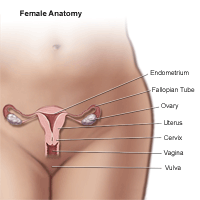Vulvitis
What is vulvitis?
 |
| Click Image to Enlarge |
Vulvitis is simply an inflammation of the vulva, the soft folds of skin outside the vagina. This is not a condition, but rather a symptom that results from a host of diseases, infections, injuries, allergies, and other irritants. Diagnosing and treating this condition can be frustrating because it is often difficult to determine the specific cause of the irritation.
What causes vulvitis?
Vulvitis may be caused by one or more of the following:
-
Scented or colored toilet paper
-
Perfumed soaps or bubble baths
-
Shampoos and hair conditioners
-
Laundry detergents (especially enzyme-activated "cold water" formulas)
-
Vaginal sprays, deodorants, douches, and powders
-
Douches that are too strong or used too frequently
-
Hot tub and swimming pool water
-
Synthetic undergarments without a cotton crotch
-
Rubbing against a bicycle seat
-
Wearing a wet bathing suit for a long period of time
-
Horseback riding
Who is at risk for vulvitis?
Any woman with certain allergies, sensitivities, infections, or diseases can develop vulvitis. Girls who have not yet reached puberty and postmenopausal women sometimes develop vulvitis, possibly because of inadequate levels of estrogen.
What are the symptoms of vulvitis?
The following are the most common symptoms for vulvitis. However, each individual may experience symptoms differently. Symptoms of vulvitis may include:
-
Redness and swelling on the labia and other parts of the vulva
-
Excruciating itching
-
Clear, fluid-filled blisters (present when the vulva is particularly irritated)
-
Sore, scaly, thickened, or whitish patches (more prevalent in chronic vulvitis) on the vulva
The symptoms of vulvitis may resemble other conditions or medical problems. Always consult your health care provider for a diagnosis.
How is vulvitis diagnosed?
In addition to a complete medical history and physical and pelvic examination, diagnostic procedures for vulvitis may include the following:
-
Blood tests
-
Urinalysis
-
Pap test (Test that involves microscopic examination of cells collected from the cervix, used to detect changes that may be cancer or may lead to cancer, and to show noncancerous conditions, such as infection or inflammation.)
Treatment for vulvitis
Specific treatment for vulvitis will be determined by your health care provider based on:
-
Your age, overall health, and medical history
-
Cause of the disease
-
Type and severity of the symptoms
-
Your tolerance for specific medications, procedures, or therapies
-
Expectations for the course of the disease
-
Your opinion or preference
Treatment may include:
-
Self-help measures (i.e., avoiding external irritants known to provoke vulvitis)
-
Sitz baths with soothing compounds (to help control the itching)
-
Hydrocortisone creams
-
Estrogen cream